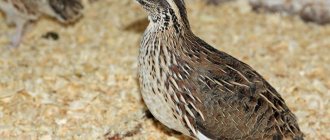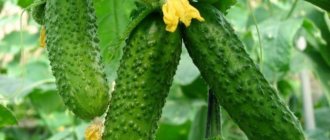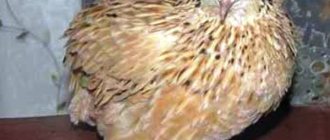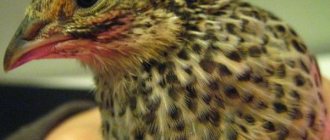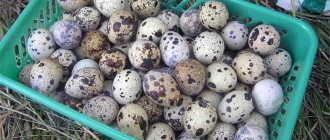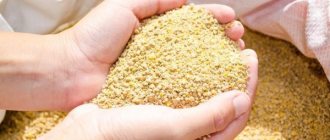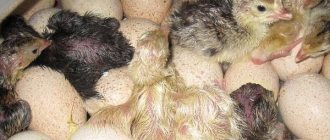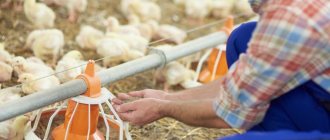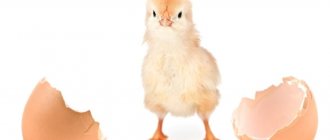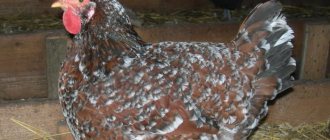Requirements for the shed
Before wintering, it is best to keep no more than 50 adult individuals in your house. Such a number of birds guarantees savings on heating the room, and the dense arrangement of birds helps to warm them up naturally. In addition, it is necessary to ensure that the young have a lot of fluff, which will allow the birds to bask on their own even on the coldest nights.
A special shed will help the quails overwinter, which even a novice poultry farmer can set up. The first criterion to adhere to is the size of the building. If the number of individuals in quail families amounts to hundreds of individuals, then you need to choose a room with an area of at least 30 square meters. m, which can accommodate up to a thousand representatives of a flock of birds.
Humidity
Quails urgently need high humidity in their place of residence - in a barn for birds it must be maintained at a high level with a minimum amount of water. When it is frosty outside the window, the best method for maintaining moisture is the proven method: a rag soaked generously in water must be hung or placed next to the quail cages. An alternative is to place a container of water directly at or nearby the birds.
The ideal humidity for birds is between 60 and 70 percent. This is due to the fact that the natural habitat of quails is wet and swampy areas.
The humidity in the poultry house where birds are kept should not be below 50 percent. If the requirement is not met, then the birds begin to drink more, as a result of which they consume less food. In addition, prolonged drought negatively affects the reproductive function of quails, which may result in a complete loss of egg production.
Lighting
Natural light is the best lighting. The barn should be equipped with large windows that can provide the birds with enough light and, accordingly, vitamin D. But in the winter season, when the sun shines infrequently and for a short time, help may be required.
An excellent solution when organizing a barn for wintering birds would be to combine heating and lighting. The best option for this is an infrared lamp. If the heating problem is not acute, then you can limit yourself to 40 W incandescent lamps or similar diode lamps with a power of up to 5 W. The main condition for the lighting regime is that the duration of daylight for quails should be at least 15 hours. Ideally, the house should be illuminated for 17-18 hours.
You can improve quail egg production by alternating light and dark periods every two hours.
Ventilation
Fresh air is extremely important for any living organism, and quail is no exception. In winter, it is much more difficult to ensure oxygen circulation in the poultry house, but nevertheless necessary.
For young animals, the optimal speed of air movement in the room is from 0.1 to half a meter per second, for adults - from 0.2 to 0.6 meters.
Temperature
Sudden changes in temperature and the presence of drafts have an extremely negative impact on the well-being of domestic quails. The first step towards a comfortable temperature for birds is a shed without holes or gaps.
In addition, the birdcage should be made of solid wood - this will help retain heat in the cold Russian winters. As you know, wood has thermal insulating properties, and, therefore, there will no longer be such an urgent need for auxiliary external heating. Lattice cages cannot boast of such an advantage, as a result of which they are not able to retain heat for a long time, and as a result, it is impossible to do without constantly running heaters during the winter season.
In a cold, drafty room, quail often begin to gather in heaps and climb on top of each other. This behavior promises inevitable death for weak birds that find themselves under the flock.
The optimal temperature for keeping birds in winter is 18 degrees Celsius. Oscillations in any direction will not benefit the quail. However, it is important to remember that the temperature in the poultry house and the temperature in the birds’ habitat are two different things. Inside a closed wooden cage, the temperature due to the heating of the space by the birds is significantly higher than the general temperature in the barn. Well-feathered three-month-old quails tolerate low temperatures much better than their older relatives who have lost part of their feathers.
How temperature and humidity affect quail performance
Quails are heat-loving birds. No wonder they fly south every autumn.
Their domesticated counterparts also need certain conditions. Poultry farmers have noticed that temperature deviations from the norm (19-22 degrees) lead to a sharp decrease in the number of eggs.
With a decrease of 5 degrees, egg laying may stop completely. This causes the quail to get sick and may die.
Higher temperatures in the barn dry out the air. If the humidity in the room is less than 50%, quails begin to drink a lot of water, refuse to feed and, as a result, stop laying eggs and gain weight.
It is necessary to monitor the humidity level in the poultry house in summer and winter. In hot weather, you need to place containers of water or hang wet rags inside the cages.
In winter, it is advisable to abandon rags, and the air dried out by heaters can easily be moistened by basins of water.
Cell requirements
Cages for wintering quails can be made of any material: stainless steel, galvanized, plywood or wood. The main thing is to comply with the physiological needs of quails and provide them with maximum comfort for laying eggs. However, when choosing your future winter residence, consider the following factors:
- In an open cage, birds will inevitably react to everything that happens around them. In this regard, the quail get nervous and stop laying eggs.
- Too much light is also not good for birds. Too high illumination provokes birds to pecking, and also causes increased anxiety, depression and decreased egg production.
- If there is a gap missing anywhere in the shed, an open cage gives carte blanche to drafts.
- Closed cage types reduce the difference in temperature between day and night, especially if the birds live in a poorly heated room.
- The appearance of chicks in the winter season requires the construction in the barn of a box made of durable wood with doors and bedding (sawdust is the best choice).
- Covering the ceiling with foam rubber not only improves thermal insulation, but also helps reduce bird injuries - some quails can jump to great heights and inevitably hit the hard surface of the ceiling without a foam layer.
- When choosing a cage format for wintering, it is better to give preference to one large cage with partitions that allow you to separate males and females as needed. One large cage instead of several small ones will allow the birds to keep each other warm.
Read how to make a quail cage with your own hands here.
Barn cleaning and hygiene procedures
Regardless of the time of year, a responsible poultry farmer needs to remember not only the general recommendations regarding living conditions, but also that birds should live in a clean environment. To maintain hygiene in the poultry house, disinfection measures are carried out on a regular basis in the areas where the birds are.
Before cleaning, the bird families are temporarily removed from the cage, and the home itself is thoroughly washed and cleaned:
- The bottom, bars and ceiling of the cage should be washed with soap. To do this, rub a bar of soap (preferably tar) with a damp sponge well and clean the cage. You can also use a washcloth soaked in soapy water.
- Rinse the soap off the cage using plenty of boiling water.
- Dry well. It is better to use a hair dryer for these purposes. Approach cell drying with all responsibility. Otherwise, the poultry house may become damp, and various microorganisms develop well in dampness.
Disinfection barrier
To avoid the development of quail diseases indoors during the winter season, when birds are most susceptible to them, it is recommended to install simple disinfection barriers. Anyone, even a beginner poultry farmer, can do it with their own hands.
To build a disinfection barrier, you will need:
- a box or basin with sides so low that you cannot trip over them (usually up to 5 cm);
- sawdust, foam rubber or other filler, the main condition is that it must absorb well;
- a piece of burlap the size of a box;
- any disinfectant.
To assemble this simple but effective design, you will need to complete several steps:
- Fill the container with filler so that it covers the bottom by a couple of centimeters.
- It is good to soak it in disinfectant, but so that it does not spill out when pressed.
- Cover with burlap.
When the owner of the birds enters the barn, he is required to stand with his feet on the barrier. This action allows you to disinfect shoes and prevent the entry of pathogens into the poultry house.
Disinfection of the poultry house in winter
In addition to washing and disinfection barriers, the quail’s home in winter must be periodically treated with disinfectants. For these purposes the following are used:
- Sodium hydroxide. The solution is used to irrigate surfaces at a concentration of 3 liters of solution per 1 square meter. m of barn. Birds should not be allowed in for three hours from the moment of treatment.
- Freshly slaked lime. It is necessary to cover the walls and ceiling with whitewash in a concentration of 200 milliliters per 1 square meter. m. Do not let birds in until completely dry.
- Phospar. The solution should be used to irrigate equipment at a concentration of 2 liters of solution per 1 square meter. m. Do not allow birds in for three hours from the moment of treatment.
- Formaldehyde. Equipment, all surfaces and air are treated with an aerosol at a concentration of 20 milliliters per 1 cubic meter. m of water. Do not allow birds in for 24 hours from the moment of treatment.
- Ammonia. The entire space of the poultry house is treated with an aerosol at a concentration of 10 milliliters per 1 cubic meter. m of water. Birds are not allowed in for 1 hour from the moment of treatment, the room is well ventilated.
Lighting at a quail farm
Quails lay eggs exclusively during daylight hours. The role of the sun in the poultry house is played by electric lamps. It is necessary to ensure that the birds' lights are on for no more than 12 hours at a time. Then the laying hens should be allowed to rest by making a “night” in the barn for 2-3 hours.
When fattening quails for meat, by adjusting the lighting, you can also achieve good results, simulating the autumn sun, reducing the length of daylight hours. The bird reflexively begins to eat, preparing for the “flight to the south.”
Using infrared lamps in quail cages gives good results. Their advantage is:
- stimulation of sexual development;
- increasing egg production;
- preventing aggression and, as a consequence, cannibalism;
- an additional source of heat in the cells.
Everyone knows the disinfecting properties of ultraviolet lamps, which are often used in industrial complexes. You can also use them on your home mini-farm. But for this, the quail barn must have ceilings at least 3 meters high.
Otherwise, birds may get burns to the cornea and go blind. And of course, these lamps cannot be used as constant lighting.
Feeding quails in winter
To ensure that birds do not get sick in winter and continue to lay eggs well, you need to pay attention not only to their living conditions, but also to their diet. It should consist of the following components:
- Compound feed. First of all, the nutrition of quails should be balanced and rich in vitamins. Therefore, it is recommended to give them feed. Today, there are several types of industrial feed for feeding quails, but you can also use homemade feed.
- Mixtures. If the poultry farmer does not have the opportunity to prepare or purchase complete high-quality compound feed, then the birds are given feed mixtures prepared independently. The composition of feed mixtures must maintain a balance between proteins, grains, vitamins and minerals.
The basis of the diet for quails in winter should be:
- millet;
- sorghum;
- all types of crushed grain (except rye);
- wheat;
- rice and pearl barley.
It is useful to give quails steamed and crushed grain legume feeds:
- peas;
- lentils;
- lupine;
- beans;
- soy
In winter, quail are in dire need of daily consumption of chopped greens, which can be replaced with grated carrots or a variety of vitamin supplements. Of all the variety of greens, it is preferable to give quails:
- tops of carrots, turnips and beets;
- green onions;
- clover;
- nettle;
- cabbage and dandelion leaves;
- alfalfa.
Due to the lack of fresh grass in winter, birds are given dried herbs prepared in summer. The necessary greens are pre-chopped. To do this, you can chop it with a knife or scroll several times in a meat grinder. But in rare cases, they also produce whole leaves - quails cope well on their own with suspended tops of carrots, turnips and beets.
In winter, it is also useful to feed quails with chopped cabbage leaves, which contain many vitamins and microelements that are beneficial for birds.
More is written about feeding quails here.
Care and rearing of young quails
The quails hatched in the incubator are transplanted into a special heated cage, or boxes made of plywood or cardboard. Quail chicks need warmth - this is the main requirement for their successful keeping, which means they will need an electric heater, an infrared lamp or, with a small number of chicks, a simple 40-60 W incandescent lamp.
It is not difficult to set up a cage with your own hands for keeping young animals at home. This cage is suitable for 60 quails, ranging in age from one day to three weeks.
The width of the cage is 150 cm, the depth is 60 cm, the height is up to 40 cm. The front wall is made of removable mesh with a mesh size of 5x5 mm, the mesh floor is made of mesh with a mesh size of 1x1 cm, and a tray is installed under it to collect litter. All other walls are made of available materials - boards, plywood, chipboard; in such a box it is easier to maintain a stable temperature and shy quails will feel protected.
A lamp is placed in one part of the cage - there the young animals can bask, and on the other wall there are feeders and an automatic waterer on a jar. It is undesirable for the lamp to heat the water - the quail will not drink hot liquid. In the first week, the floor is covered with newspapers.
Young animals at the age of 24 hours need a temperature of + 37 °C, then the heating is gradually reduced. The temperature for keeping adult quails should be at least +19-20 °C. Air humidity – 60-70%.
The table below provides indicators for temperature and duration of illumination.
Temperature and lighting indicators
The cage with the quails should not be taken outside, even in good weather. Quail is a strong and resilient bird, but in adulthood. In young animals, even a light wind or a slight drop in temperature can lead to colds and death.
In the first two weeks, 24-hour lighting is installed for quails, then the photoperiod is gradually reduced. By the age of a month, quails are left with light for 12 hours a day. Then, for productive flocks kept per egg, daylight hours are increased starting from the fifth week, increasing to 16 hours by the eighth week.
In the first days, the diet consists of a feed mixture, which includes sifted cereals, usually millet, or mixed feed with chopped eggs, all finely ground. Some breeders give babies special feed from the first day, and in this case eggs are not fed.
Quail up to a week old are fed at least six times a day, gradually reducing the number of feedings, bringing the regime to two meals a day. After a month, the young animals can be given food for adults. It is impossible to abruptly transfer from one diet to another; the transition is made gradually. Read more about feeding quails in a separate article.
Helpful Tips and Tricks
Keeping quails in winter has its own subtleties and nuances that should be remembered:
- Despite the fact that these domestic birds have a very stable immunity to most avian diseases that quickly spread in winter, if the conditions of the flock are violated, feather loss, pecking and cannibalism can occur. The causes of these problems, as a rule, are poor-quality food and its lack, colds, overcrowding, elevated temperatures and dry indoor conditions.
- The presence of too bright lighting and other irritating factors at any time of the year, and especially in winter, puts quails into a state of stress, as a result of which laying hens lose egg production, and males become aggressive and begin to fight.
- In winter, especially in rural areas, power outages often occur. In this regard, the poultry farmer should take care of autonomous devices (generators) to supply heat and light to the premises where the quail are kept.
- You should not start raising quails with a large population of a thousand or more birds. It is better to gain experience in breeding quails with a number of several hundred individuals. Birds accustomed to living in the wild, with careful care and plenty of food, will delight their owners with high productivity even in winter.
General Content Rules
Quails do not like sudden changes in environment. Therefore, you should not keep quails in one place in summer and in another in winter. Such “moves” are fraught with the risk that females stop laying eggs, and the adaptation process can drag on for a long time.
In both winter and summer, the temperature of quails should fluctuate between 19-22 degrees. The acceptable minimum is 17 degrees.
If the region has a cold winter, you will have to take care of additional heating of the barn. Using convection or infrared heaters. Be sure to monitor the humidity in the room. Its optimal indicators: 55–75%.
You can read about other norms and recommendations that must be followed when raising laying quails or quails for meat in the article “On raising quails at home: for beginners and experienced ones.”
Keeping quails in a barn in winter (video recommendations)
This video provides some useful recommendations for equipping a room for quails for the winter and rules for keeping these birds in the winter:
Wintering quails is a serious and responsible process, which can be a test even for an experienced poultry farmer. However, suitable living conditions, food and regular hygiene measures will allow small birds to easily endure the harsh Russian winters.
0
0
Copy link
